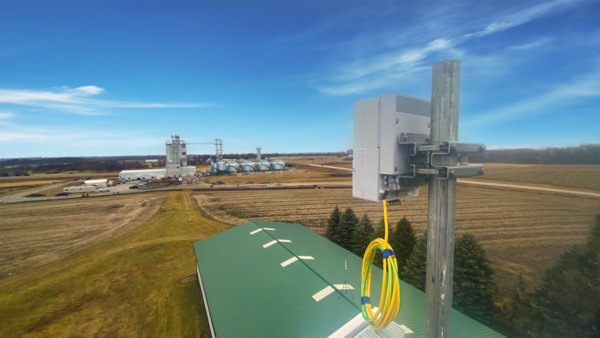Ericsson and U.S. PAWR 5G SA network for rural agricultural research
Ericsson in cooperation with the U.S. National Science Foundation’s (NSF) Platforms for Advanced Wireless Research (PAWR) program announced the launch of its 5G SA network for public research together with the Agriculture and Rural Communities (ARA) team at Iowa State University (ISU). Powered by Ericsson, the network is part of ARA’s multi-modal platform for wireless research, based on the ISU campus with coverage extending to local crop and livestock farms and parts of the city of Ames.
The Ericsson-powered 5G SA network will be used to support precision agriculture applications, along with other research initiatives, and is already connecting farm sites that previously had little to no broadband access. ARA is partnering with the ISU Department of Agriculture and Biosystems Engineering as well as the College of Agriculture of Life Sciences for initial precision agriculture research projects.

Ericsson and PAWR light up 5G network for rural agricultural research
Image Credit: Ericsson
“As we continue to unlock 5G’s full potential, we’re excited to support ARA’s cutting-edge research on precision agriculture, rural broadband, renewable energy, and public safety for smart and connected rural communities,” said Per Wahlen, Vice President and Head of Business Development, Ericsson North America.
Sample agriculture research will include using connected robots (PhenoBots) to collect plant phenotyping data with stereoscopic cameras generating 800 megabits per second worth of sensor data per camera. It will also include livestock monitoring with high-resolution cameras, as well as agriculture automation.
The Ericsson-powered network consists of a 5G core operating in SA mode and NR radios which operate in both mid-band and millimeter wave spectrum bands with a high aggregate throughput up to 3Gbps. The outdoor network will run 5G SA with mid and high band New Radio-Dual Connectivity (NR-DC) with a downlink exceeding 2.5Gbps in outdoor live testing. With ultra-low latency, increased capacity and coverage, and support for end-to-end network slicing, Ericsson’s 5G SA solutions ensure instant response times and enable new use cases.
ARA is part of the National Science Foundation-funded Platforms for Advanced Wireless Research (PAWR) program that works to create wireless testbeds through public-private partnerships to accelerate the nation’s wireless ecosystem.
“As ARA aims to help close the gap between academic and industry research in the wireless and agricultural sectors, we’re excited to announce the Ericsson network component, which is open for joint opportunities for both academic and industry research endeavors,” said Hongwei Zhang, Principal Investigator of ARA and Director of the Center for Wireless, Communities and Innovation, Iowa State University.
Andrew Wooden of telecoms.com wrote:
The concept of the smart farm – like the smart city – made up part of the hype fodder for the initial 5G launch. Since 5G SA is considered ‘proper’ 5G the line seems to now be that it will be the required driving force behind all sorts of industries being revolutionised by high bandwidth and low latency mobile connectivity.
How large a commercial market applications like this represents for kit vendors like Ericsson in the near future remains to be seen, but if it does represent a teaser of how food can be grown better or more abundantly – as is presumably the end goal – we can think of much more frivolous use cases presented over the years.
These 5G SA networks my play an important role in the future of the U.S. agricultural ecosystem. ARA and Ericsson are in forward-leaning positions to support the realization of recently proposed bipartisan legislation surrounding the issue of broadband access to unserved rural farms, through applied research and innovative use case development to assist farmers and rural communities.


